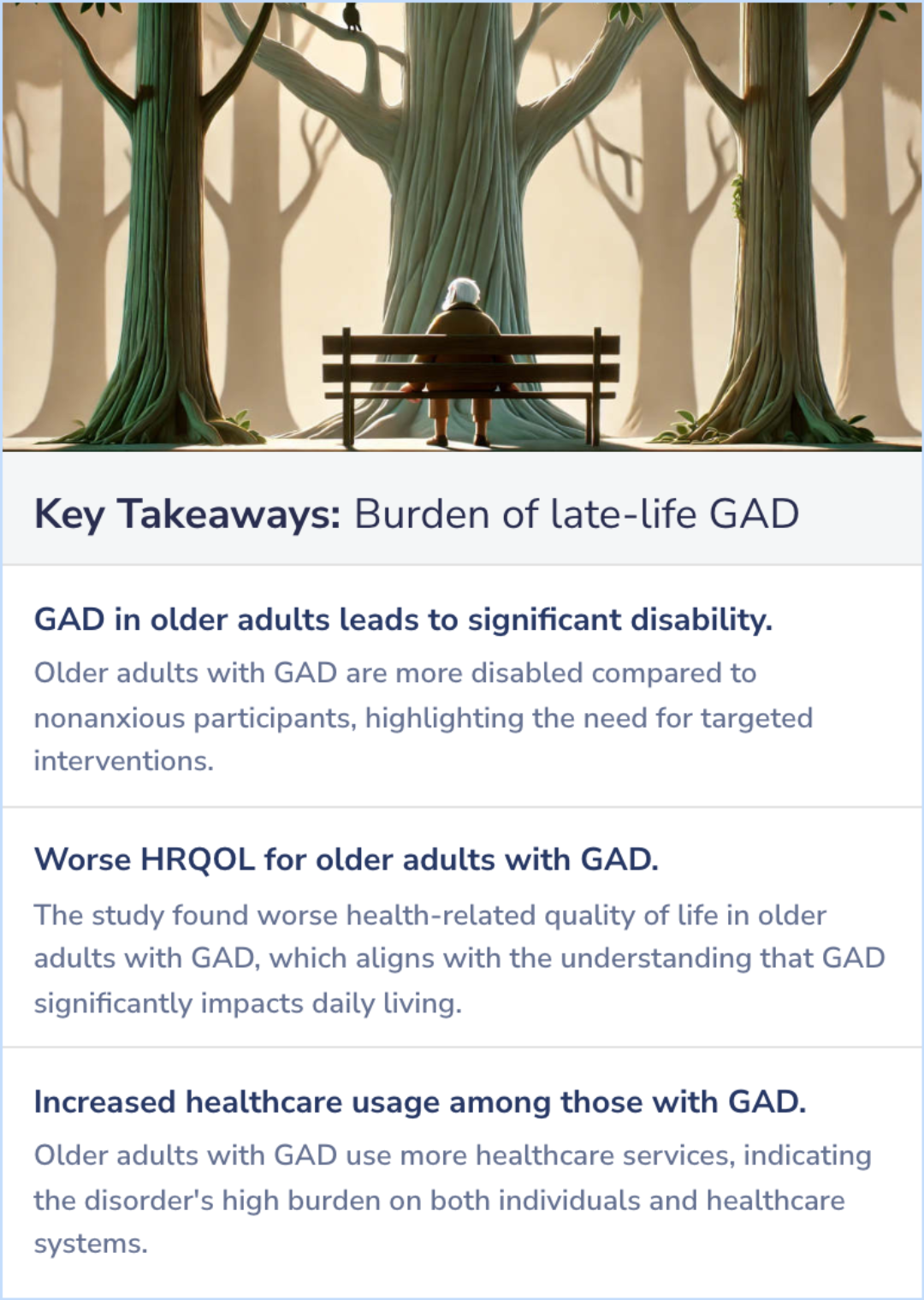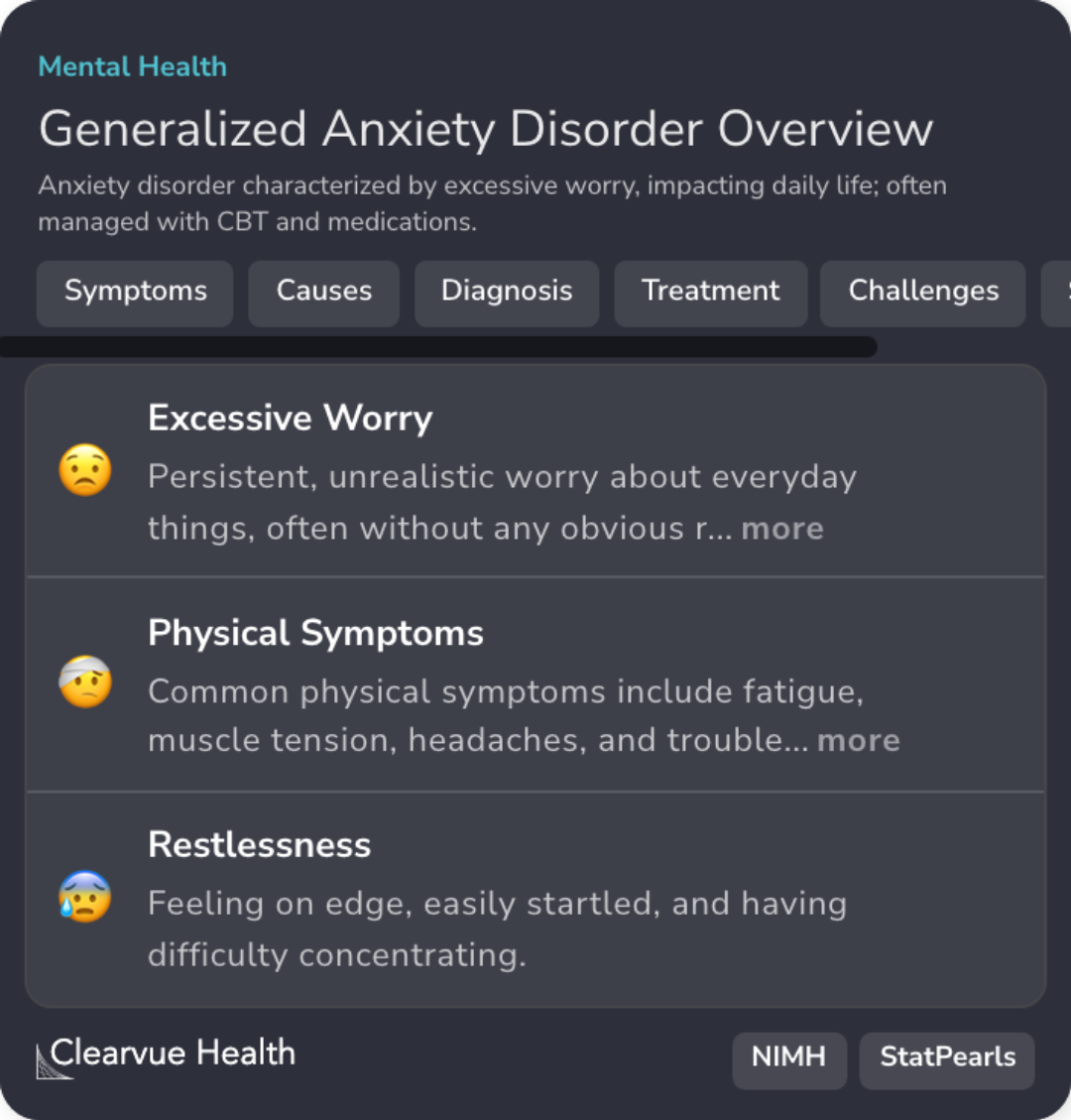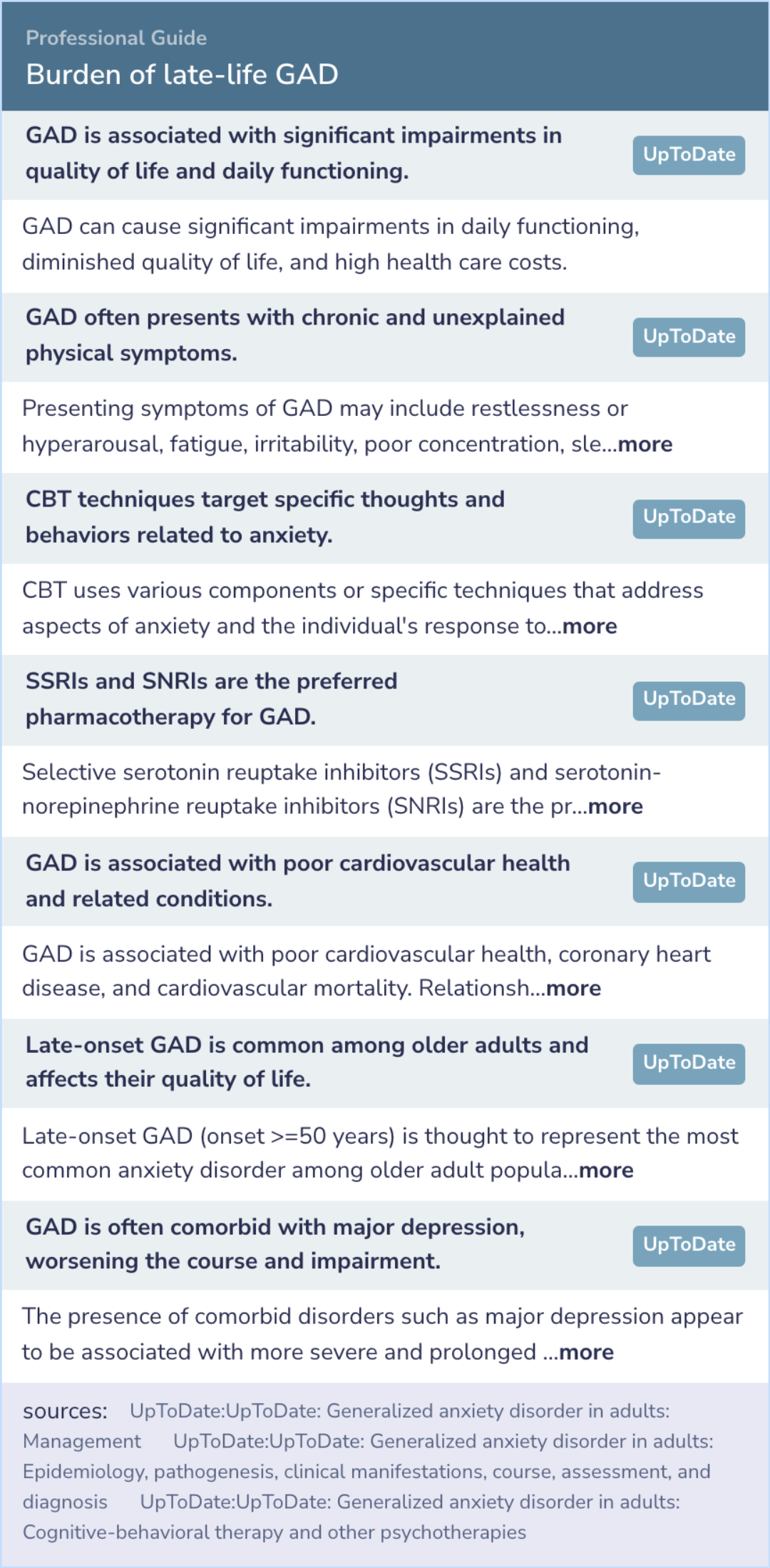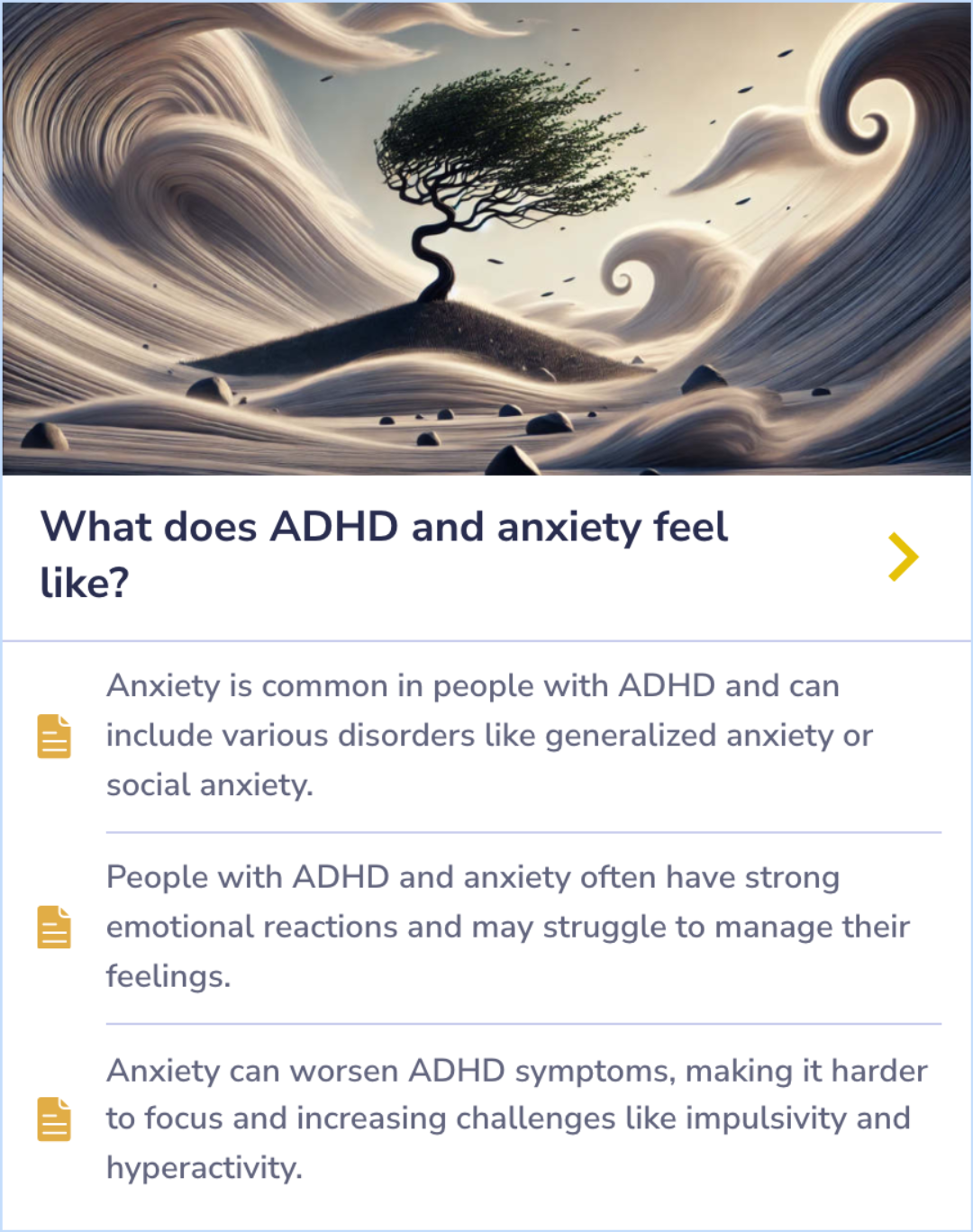Generalized Anxiety Disorder Papers
Visual Abstract
The burden of late-life generalized anxiety disorder: effects on disability, health-related quality of life, and healthcare utilization
Burden of late-life GAD
November 25, 2024
author
Porensky EK, Dew MA, Karp JF, Skidmore E, Rollman BL, Shear MK, Lenze EJ
journal
Am J Geriatr Psychiatry
Date Published
2009 Jun
Why link to a visual abstract?
What is a visual abstract?
Original

Study Summary
🔬
What They Studied
The main research question was to describe the burden of Generalized Anxiety Disorder (GAD) in older adults.
💡
What They Found
They found that older adults with GAD were more disabled, had worse health-related quality of life (HRQOL), and used more healthcare services compared to nonanxious participants.
📚
What This Means
These findings suggest that older adults with GAD experience significant functional impairments and a lower quality of life, aligning with current evidence that GAD has a large impact on daily living and requires effective management strategies.
Study Summary
Study Overview
The study aimed to explore the effects of generalized anxiety disorder (GAD) on older adults, looking at how it impacts their daily lives and overall well-being. The findings highlighted a significant burden, showing that older adults with GAD face challenges in managing daily activities. These challenges occur even in the absence of other psychiatric or medical issues, suggesting a need for better identification and support for this group.
Overall, the research underscores the importance of recognizing GAD as a serious concern in late life, with implications for enhancing mental health care for the elderly.
Overall, the research underscores the importance of recognizing GAD as a serious concern in late life, with implications for enhancing mental health care for the elderly.
Abstract: background
To describe the burden of Generalized Anxiety Disorder (GAD), a common anxiety disorder in older adults.

Public Health Need
"Given the high prevalence and chronicity of GAD in the elderly, these data provide a public health imperative for finding and implementing effective management strategies for this typically undiagnosed and untreated disorder."
Impact on Quality of Life
"In sum, the results of the present investigation add to the body of evidence showing that late-life GAD is associated with significant disability and marked impairment in HRQOL, which is not attributable to the common medical and psychiatric comorbidity with this condition."
GAD Symptoms and Daily Activities
"Even in the absence of current psychiatric comorbidity, older adults with GAD had more difficulty in carrying out daily activities than individuals without GAD, and they also engaged less frequently in such activities."
Study Summary
Methods
The study employed a cross-sectional design at a research clinic in Pittsburgh, PA. It involved 164 older adults diagnosed with GAD and 42 healthy participants with no history of psychiatric disorders. Participants were recruited through primary care and mental health settings, and advertisements.
Various tools were used for evaluation: the Late Life Function and Disability Index for disability, the MOS 36-Item Short Form Survey for health-related quality of life (HRQOL), and the Cornell Service Index for healthcare utilization. These measures provided insights into the impact of GAD on participants' daily functions and health services use.
Various tools were used for evaluation: the Late Life Function and Disability Index for disability, the MOS 36-Item Short Form Survey for health-related quality of life (HRQOL), and the Cornell Service Index for healthcare utilization. These measures provided insights into the impact of GAD on participants' daily functions and health services use.
Abstract: methods
Cross-sectional. Late-life depression and anxiety research clinic in Pittsburgh, PA. One hundred sixty-four older adults with GAD and 42 healthy comparison participants with no lifetime history of psychiatric disorder were recruited from primary care...more

Study Summary
Results
Findings indicated that older adults with GAD experienced greater disability and worse health-related quality of life than those without anxiety disorders. They also had higher healthcare utilization. These associations held true even without other psychiatric conditions.
Greater anxiety severity was linked to increased disability and poorer HRQOL, particularly in areas of social role functioning. These results suggest a significant impact of GAD on various aspects of life, stressing the importance of addressing this condition.
Greater anxiety severity was linked to increased disability and poorer HRQOL, particularly in areas of social role functioning. These results suggest a significant impact of GAD on various aspects of life, stressing the importance of addressing this condition.
Abstract: results
Older adults with GAD were more disabled, had worse HRQOL, and had greater healthcare utilization, than nonanxious comparison participants, even in the absence of psychiatric comorbidity. After controlling for medical burden and depressive symptoms, ...more

Study Summary
Conclusions
This large-scale study of GAD in older adults highlights the considerable impact of the disorder on their lives. GAD contributes to significant disability and a decreased quality of life in the elderly.
Given its high prevalence and chronic nature, addressing GAD is a public health imperative. Effective management strategies are crucial, as this disorder often goes undiagnosed and untreated in older populations.
Given its high prevalence and chronic nature, addressing GAD is a public health imperative. Effective management strategies are crucial, as this disorder often goes undiagnosed and untreated in older populations.
Abstract: conclusions
This study, the largest ever of GAD in older adults, provides evidence of the significant burden of this disorder in late life. Given the high prevalence and chronicity of GAD in the elderly, these data provide a public health imperative for finding ...more

Background Information
Patient Guide
😟
Prevalence of GAD in Older Adults
GAD affects a significant portion of the elderly, who experience excessive worry impacting daily life.
🤕
Impact on Physical Health
Common physical symptoms in GAD include fatigue, muscle tension, headaches, and trouble sleeping.
🔗
Comorbidity with Depression
GAD often occurs alongside other mental health disorders such as depression, complicating its treatment.
💊
Increased Healthcare Utilization
Older adults with GAD often require more healthcare services due to the chronic nature of their symptoms.
🔄
Challenges of Long-Term Management
GAD tends to be a long-term condition with a risk of relapse, particularly in the elderly population.

Professional Guide
Expert Opinion: Burden of late-life GAD
The findings suggest that older adults with GAD experience substantial impairments, aligned with existing knowledge on the effects of the disorder.
Current professional recommendations state that CBT is effective in reducing symptoms and improving daily functioning, while SSRIs and SNRIs are preferred pharmacotherapies.
Additionally, GAD is often associated with physical symptoms and poor cardiovascular health, further complicating its management in older populations.
Consistent with these recommendations, targeted CBT techniques address specific thoughts and behaviors related to anxiety.
Current professional recommendations state that CBT is effective in reducing symptoms and improving daily functioning, while SSRIs and SNRIs are preferred pharmacotherapies.
Additionally, GAD is often associated with physical symptoms and poor cardiovascular health, further complicating its management in older populations.
Consistent with these recommendations, targeted CBT techniques address specific thoughts and behaviors related to anxiety.
Evidence Summary
ADHD, Anxiety, and the Impact on Medication Response
The connection between ADHD and anxiety is complex. Anxiety can sometimes reduce impulsivity and hyperactivity in individuals with ADHD, which may sound positive, but it can actually worsen overall symptoms. This can also alter how these individuals respond to medications like Ritalin.
While anxiety might decrease certain ADHD behaviors, it complicates the overall picture, making treatment responses more unpredictable and challenging.
While anxiety might decrease certain ADHD behaviors, it complicates the overall picture, making treatment responses more unpredictable and challenging.
Evidence Summary
How Anxiety Intensifies ADHD Symptoms
Anxiety often accompanies ADHD, intensifying emotions and increasing challenges like test anxiety. These issues can manifest in various forms, such as generalized or social anxiety, complicating the ability to focus and manage impulsivity.
People with ADHD and anxiety experience strong emotional reactions, making it more difficult to control their feelings, which further exacerbates ADHD symptoms like hyperactivity.
People with ADHD and anxiety experience strong emotional reactions, making it more difficult to control their feelings, which further exacerbates ADHD symptoms like hyperactivity.


